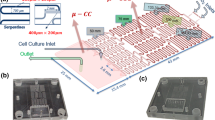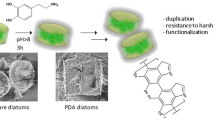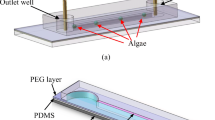Abstract
This paper presents a simple method for modifying the polydimethylsiloxane (PDMS) microfluidic channels with Teflon for algal lipid research. When culturing and staining algae inside microfluidic devices, the small molecule dyes absorbed by the microchannel surface render it difficult for imaging and quantification. PDMS surface coated with Teflon-AF resists the absorption of hydrophobic dye molecules (i.e., BODIPY and Nile red) as confirmed using fluorescence microscopy. Here, we introduce a surface modification of PDMS microchannel using Teflon-AF using a procedure of filling and drying to directly treat the PDMS surface with perfluorinated materials. This method can be used to prevent the absorption of fluorescent probe and obtain clear fluorescence micrographs without background signal from absorbed dye molecules on PDMS microchannel. We confirmed that contact angle of Teflon-coated PDMS (116.4°) is higher than that of unmodified PDMS (106.1°) and thus more hydrophobic. Furthermore, Teflon-coated PDMS surface had ~80% of oxygen transfer rate compared to that of native PDMS and good transparency in all visible light regions. Based on these characteristics, we successfully validated the visualization and quantification of intracellular lipid droplets in microalgae C. reinhardtii using BODIPY. We believe that our new method will expand microfluidic applications on characterization of biological lipid with fluorescence probes and biochemical markers.
Similar content being viewed by others
References
Breslauer, D.N., Lee, P.J. & Lee, L.P. Microfluidics-based systems biology. Mol. Biosyst. 2, 97–112 (2006).
Na, S. et al. Microfluidic neural axon diode. Technology 1–9 (2016)
Keenan, T.M. & Folch, A. Biomolecular gradients in cell culture systems. Lab Chip 8, 34–57 (2008).
Kim, S., Kim, H.J. & Jeon, N.L. Biological applications of microfluidic gradient devices. Integr. Biol. 2, 584–603 (2010).
Kang, M. et al. Capillarity Guided Patterning of Microliquids. Small 11, 2789–2797 (2015).
Owen, M.J. & Smith, P.J. Plasma treatment of polydimethylsiloxane. J. Adhes. Sci. Technol. 8, 1063–1075 (1994).
Ni, M. et al. Cell culture on MEMS platforms: A review. Int. J. Mol. Sci. 10, 5411–5441 (2009).
Choi, S.-J. et al. A polydimethylsiloxane (PDMS) sponge for the selective absorption of oil from water. ACS Appl. Mater. Inter. 3, 4552–4556 (2011).
Berthier, E., Young, E.W. & Beebe, D. Engineers are from PDMS-land, Biologists are from Polystyrenia. Lab Chip 12, 1224–1237 (2012).
Sasaki, H., Onoe, H., Osaki, T., Kawano, R. & Takeuchi, S. Parylene-coating in PDMS microfluidic channels prevents the absorption of fluorescent dyes. Sens. Actuators, B 150, 478–482 (2010).
Ren, K., Zhao, Y., Su, J., Ryan, D. & Wu, H. Convenient method for modifying poly (dimethylsiloxane) to be airtight and resistive against absorption of small molecules. Anal. Chem. 82, 5965–5971 (2010).
Mays, R.L., Dickey, M.D. & Genzer, J. Microfluidic channels fabricated from poly (vinylmethylsiloxane) networks that resist swelling by organic solvents. Lab Chip 13, 4317–4320 (2013).
Ren, K., Dai, W., Zhou, J., Su, J. & Wu, H. Whole-Teflon microfluidic chips. Proc. Nat. Acad. Sci. 108, 8162–8166 (2011).
Drummond, C.J., Georgaklis, G. & Chan, D.Y. Fluorocarbons: surface free energies and van der Waals interaction. Langmuir 12, 2617–2621 (1996).
Wu, C.-W. & Gong, G.-C. Fabrication of PDMS-based nitrite sensors using Teflon AF coating microchannels. IEEE Sens. J. 8, 465–469 (2008).
Cho, S.H., Godin, J. & Lo, Y.-H. Optofluidic waveguides in Teflon AF-coated PDMS microfluidic channels. IEEE Photon. Technol. Lett. 21, 1057–1059 (2009).
Johnson, I.D., Kang, H.C. & Haugland, R.P. Fluorescent membrane probes incorporating dipyrrometheneboron difluoride fluorophores. Anal. Biochem. 198, 228–237 (1991).
Wang, J. et al. Microfluidics: a new cosset for neurobiology. Lab Chip 9, 644–652 (2009).
Whitesides, G.M. The origins and the future of microfluidics. Nature 442, 368–373 (2006).
Unger, M.A., Chou, H.-P., Thorsen, T., Scherer, A. & Quake, S.R. Monolithic microfabricated valves and pumps by multilayer soft lithography. Science 288, 113–116 (2000).
Farese, R.V. & Walther, T.C. Lipid droplets finally get a little RESPECT. Cell 139, 855–860 (2009).
Walther, T.C. & Farese, R.V. The life of lipid droplets. Biochim. Biophys. Acta 1791, 459–466 (2009).
Sacher, E. & Susko, J.R. Water permeation of polymer films. IV. Teflon FEP. J. Appl. Polym. Sci. 27, 3893–3902, doi:10.1002/app.1982.070271023 (1982).
Author information
Authors and Affiliations
Corresponding author
Electronic supplementary material
Rights and permissions
About this article
Cite this article
Park, J.W., Na, S., Kang, M. et al. PDMS microchannel surface modification with teflon for algal lipid research. BioChip J 11, 180–186 (2017). https://doi.org/10.1007/s13206-017-1302-0
Received:
Accepted:
Published:
Issue Date:
DOI: https://doi.org/10.1007/s13206-017-1302-0




